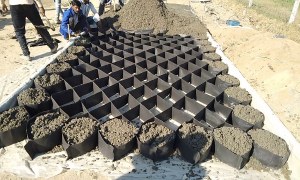🕑 Reading time: 1 minute
The organic prestressing system is a concept taken as an inspiration from the behavior of an organic structure (biomimetic or the nature formed structures) that is derived from nature, called the muscle. This resemble an active control system of prestressing. The main objective of organic prestressing system is to reduce the stresses or the deformations caused due to the live load. The OPS can be defined as an automatic adaptive prestressing system that has the capability to either increase or decrease the prestressing force based on the load variation under service conditions of the structure. For more understanding, one can express the organic prestressing system as a prestressing system that automatically adjust the tension applied to the cables based on the loads actuated. This is carried out by means of a control system. This adjusting serve the objective of minimizing the tensions and the structural deformations. The development of OPS originated by a research project on Organic Prestressing which was initiated in FEUP. The results of the first numerical simulations bought a conclusion that the organic prestressing is mainly useful for the bridge equipment structures. As the bridge construction have large importance on the variation in live load and deformations, the OPS can work best for the same. The development of OPS can be explained in the following stages of development, as shown in the table below. Table.1.OPS Technology – Historic Synopsis| Year | Accomplishments |
| 1994-1999 | The R&D stage is developed at FEUP |
| 2003 | The initial lab model |
| 2004 | The first application of OPS system in full scale. The pilot project developed in FEUP |
| 2009 | The OPS Bowstring Concept for 70M span |
| 2011 | Upgrade of OPS for temperatures less than zero, First Large Viaduct; Multi-span |
| 2013 | The first application of OPS for Cable stayed |
| 2014 | Precast Segmental Construction – Use of OPS in launching Gantries |
| 2015 | Application on 90-meter Span Multi -span Viaducts |
Contents:
Organic Prestressing System Browsing Concept
The OPS browsing system was developed between the period 2007 and 2009. The overhead equipment is gained by some of the browsing concept. The browsing concept have certain advantages in applications like in the movable scaffolding systems (MSS). The movable scaffolding systems help in construction of bridge have curved curvature. This makes the assemblage more important. This method brings more stability in the launching stage. The organic prestressing system concept have also been developed in large movable scaffolding systems (LMSS).
Fig.1: Main Components of Organic Prestressing System Browsing Concept
Elements and Concept of Organic Prestressing System
The main elements of OPS system considering the bridge construction equipment as the explanatory reference are the:- The activator and the active anchorage
- The un-bonded cables used
- The sensors
- The electronic controller is present in the girder control unit
- The passive anchorage
- The deviation shores
 Fig.2: The main elements involved in a OPS technology in Bridge Construction
Fig.2: The main elements involved in a OPS technology in Bridge Construction
Advantages of Organic Prestressing System
Some of the advantages that is gained by the installation of OPS system are:- Lighter design of structures
- Construction of efficient structures
- Reduction of weight have good impact on the operational and the productivity cost
- The load carrying capacity is increased
- Efficiency of Work is Improved
Applications of Organic Prestressing System
The OPS system has been applied in the launching of gantry equipment in segmental construction of bridges. The OPS technology works best for the construction of long span bridges. Other than the advantages mentioned above, it also has the capability to overcome the challenges like:- Excessive weight of the Equipment
- Construction time - Delay in construction time due to difficulty in the equipment management is reduced by the OPS technology.
- The versatility of the scaffolding equipment is improved
- The transportation is made easy
- The site assemblage is made easy
- The space required for the storage of equipment is reduced.
- Productivity
- Instability of large spans
Features of Organic Prestressing Technology
The main features of OPS technology in bridge construction are:- The reduction of mid-span deflection.
- Reduction of mid-span deflection in the case of launching gantries.
- Equipment that are lighter in construction are attained
- Ensure higher load capacity for the equipment
- Higher safety level is ensured by having continuous monitoring of the scaffolding structures.
- The OPS technology has ability to predefine the deflections.
- More simpler steel connections are employed by the OPS technology. This will help in the reduction of tension.


